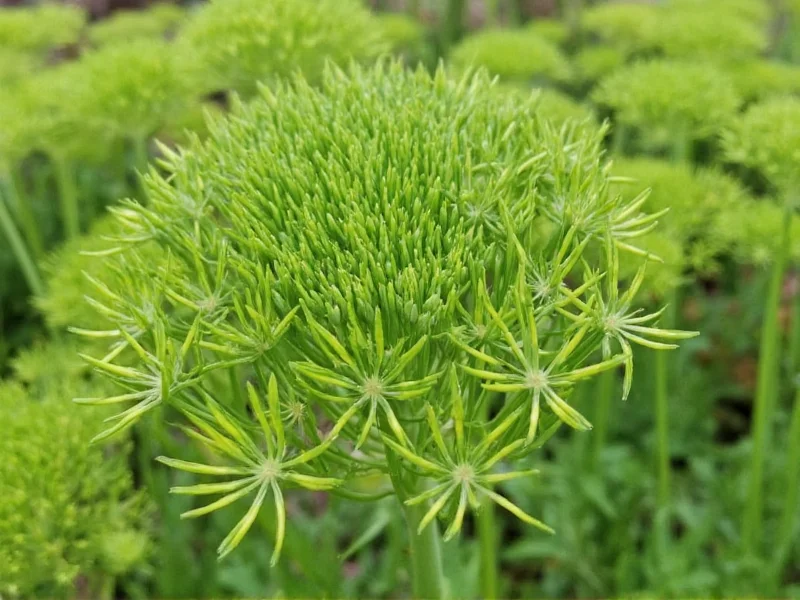Understanding the distinctive appearance of dill heads helps gardeners, shoppers, and cooks identify this valuable herb at different growth stages. Unlike the feathery fronds commonly sold as "dill weed," the seed head represents the plant's flowering stage and contains the prized dill seeds used in pickling and cooking.
Anatomy of the Dill Plant
Dill (Anethum graveolens) progresses through several distinct growth phases. The familiar feathery green fronds (dill weed) emerge first, followed by the flowering stage where the characteristic seed heads develop. These heads form at the top of mature dill plants, typically 2-4 feet tall, when the plant reaches 60-90 days of growth.
Detailed Visual Characteristics
A mature dill head features:
- Shape: Umbrella-like structure (technically called an umbel) with multiple slender rays radiating from a central point
- Size: Typically 2-4 inches in diameter when fully developed
- Color progression: Starts as pale yellow flowers, matures to golden yellow, then transitions to light brown as seeds form
- Texture: Delicate, almost lacy appearance with fine branching
- Components: Hundreds of tiny individual flowers that develop into seed pods containing 2-3mm oval seeds
| Growth Stage | Appearance | Best For |
|---|---|---|
| Young Fronds | Feathery green leaves, 6-12" tall | Fresh cooking, salads |
| Flowering Stage | Pale yellow umbels, 2-4" across | Attracting pollinators |
| Seed Head Maturity | Golden yellow to light brown umbels | Seed harvesting, pickling |
Distinguishing Dill Heads from Similar Plants
Many confuse dill with fennel due to their similar appearance, but key differences exist:
| Feature | Dill Head | Fennel Flower |
|---|---|---|
| Color | Pale to golden yellow | Bright yellow |
| Size | 2-4 inches across | 3-5 inches across |
| Foliage scent | Citrusy, grassy aroma | Strong licorice/anise scent |
| Stem texture | Smooth, hollow | Ridged, solid |
Seasonal Development of Dill Heads
Dill heads appear during the plant's second growth phase, typically from mid-summer through early fall in temperate climates. The flowering process follows this progression:
- Bud formation: Small green clusters appear at stem tips (late spring)
- Flowering: Umbels open into delicate yellow flowers (early summer)
- Seed development: Flowers transform into seed pods (mid-late summer)
- Seed maturity: Pods turn light brown and dry (late summer to early fall)
Gardeners harvesting dill seeds should watch for the color transition from yellow to brown, indicating optimal seed maturity. The entire seed head can be cut and dried upside down in a paper bag to catch the mature seeds as they fall.
Practical Identification Tips
When identifying dill heads in markets or gardens, use these reliable methods:
- Smell test: Crush a small portion of the flower cluster - genuine dill emits a distinctive citrus-grassy fragrance without strong licorice notes
- Stem examination: Dill stems are smooth and hollow, unlike fennel's ridged solid stems
- Leaf check: Look for the characteristic feathery green dill weed surrounding the base of the flower head
- Seed shape: Mature dill seeds are oval with longitudinal ridges, measuring 2-3mm long
Fresh dill heads at their flowering stage have a more delicate flavor than mature seed heads, making them excellent for garnishing dishes or infusing vinegars. The fully mature seed heads provide the stronger flavor preferred for pickling and bread baking.
Common Misidentifications
Several plants get mistaken for dill heads:
- Fennel flowers: Larger, brighter yellow, with stronger licorice scent
- Caraway: Smaller umbels with finer leaves and different seed shape
- Cilantro flowers: White flowers rather than yellow, with different leaf structure
- Wild dill vs. cultivated: Wild dill tends to have smaller, more sparse flower heads
Understanding what a head of dill looks like prevents costly mistakes when shopping or foraging. Grocery stores typically sell either the fresh fronds (dill weed) or packaged seeds, but specialty markets may offer fresh dill heads during peak season.
Using Dill Heads in Culinary Applications
Dill heads serve multiple culinary purposes beyond just seed harvesting:
- Place entire heads in pickle jars for traditional dill pickles
- Infuse vinegars or oils by steeping fresh flower heads
- Add whole flowering umbels to Scandinavian gravlax
- Use as edible garnish for fish dishes and potato salads
- Dry and crumble mature seed heads for homemade dill seed
The flowering stage represents the plant's reproductive phase, so allowing dill to form heads reduces leaf production. Gardeners wanting maximum leaf harvest should pinch off developing flower heads early in the season.











 浙公网安备
33010002000092号
浙公网安备
33010002000092号 浙B2-20120091-4
浙B2-20120091-4